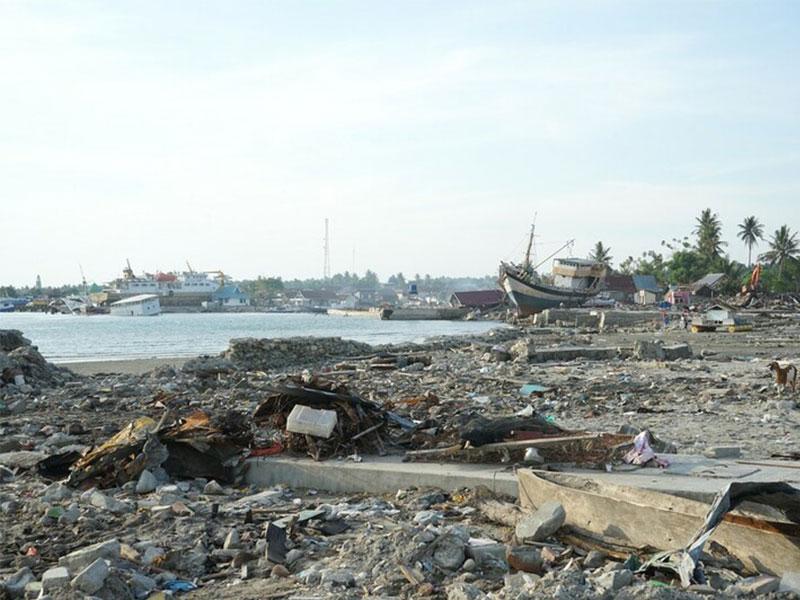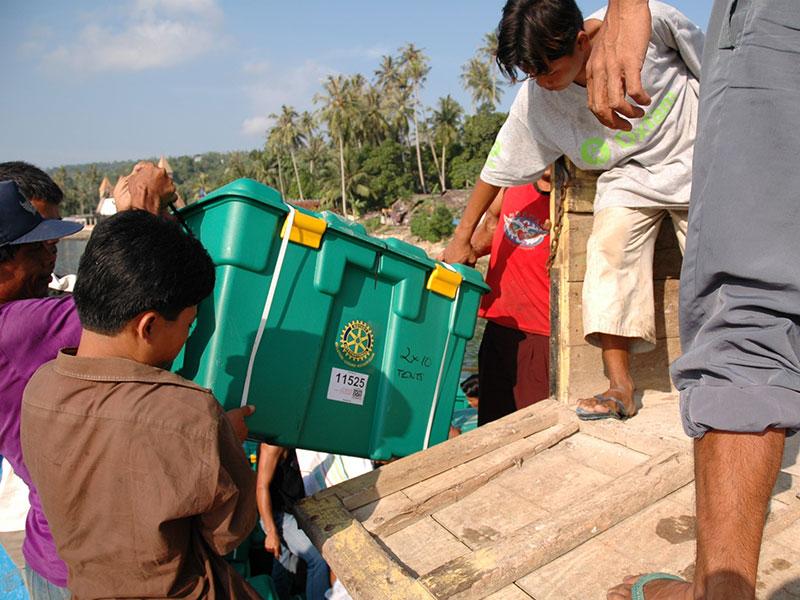Disasters Explained
Learn more about the types of disasters and how each one impacts the people affected.
A tsunami is a series of giant, fast-moving waves caused by volcanic eruptions, earthquakes or landslides. Tsunamis should not be confused with Tidal Waves – these are waves generated on the surface of the ocean by wind, tidal pull from the moon, and the position of the earth.
It sends a surge of water onto land, often reaching heights of over 100 feet. Although tsunami waves do not reach great heights out in the depths of the ocean, as they enter shallower water they begin to grow in energy and height.
Tsunami waves can tear across the sea at speeds of 500 miles an hour. The speed is determined by the depth of the ocean – travelling as fast as a jet plane over deep waters and slowing down when reaching shallow waters.
They are rare, usually happening around twice a year, but they can have devastating effects. Entire communities can be destroyed by these powerful waves – lives, homes, crops, roads, bridges, and airports can all be completely swept away.

What exactly is a tsunami?
A tsunami is a series of giant, fast-moving waves caused by volcanic eruptions, earthquakes or landslides. Tsunamis should not be confused with Tidal Waves – these are waves generated on the surface of the ocean by wind, tidal pull from the moon, and the position of the earth.
They are rare, usually happening around twice a year, but they can have devastating effects. Entire communities can be destroyed by these powerful waves – lives, homes, crops, roads, bridges, and airports can all be completely swept away.
Why do tsunamis happen?
The large waves that form a tsunami happen when there is an earthquake under the ocean. When large slabs of rock are forced to move past each other causing the water above to move. Other things can make tsunamis too, such as volcanic eruptions, sub-marine rockslides or a large impact in the water from an asteroid or meteor. Water will move in all directions from the location of the disturbance, starting small and getting larger and larger. Waves from a tsunami can reach 100 feet and travel as far as 5,000 kilometers.
Earthquakes
The most common cause of a tsunami is an earthquake on the seafloor. When slabs of rock move past each other suddenly, it causes the overlying water to move, sending out a series of rolling waves that grow into a tsunami.
Landslides
Underwater landslides can also cause tsunamis. The movement of rock sliding downhill draws the water down from all sides, colliding in the middle. This launches a great wave radiating out.
Volcanic eruptions
Volcanoes can create a tsunami when an explosive eruption causes the tectonic plates to move, generating huge waves. A tsunamic can also be created when large amounts of lava flow into the ocean.
Asteroid or meteor crashes in the ocean have also been known to cause tsunamis, but these are rare.

When waves caused by the underwater disturbance reach land, they will be far faster and more powerful than regular ones. They also grow in size as they approach the shallow waters near land.
These large, powerful waves can destroy buildings, roads, railways, and pretty much anything else in their path. Tsunamis can destroy whole communities leaving many people homeless and destroying their livelihoods.
After a tsunami, floodwaters and damage to infrastructure can lead to contaminated water and food supplies. This increases the risk of dangerous diseases like malaria and cholera. If families are staying in shared shelters and living at close quarters, this can make spreading diseases easier.
As with any natural disaster, people can suffer from traumatic injuries after a tsunami. What makes a tsunami different is the suddenness with which it strikes. People may even experience mental health issues such as post-traumatic stress disorder.
ShelterBox provides emergency shelter and essential tools for families affected by tsunamis and other natural disasters.
Shelter and essential items like blankets, cooking sets and mosquito nets can allow families to create a safe space to begin to recover.
Families often don’t have access to clean water in the aftermath of disasters like tsunamis so water filters and carriers can allow them to produce clean water.
Power lines can also be damaged for long periods of time, so solar lights are a practical solution, enabling families to pick up their normal routines.
We’ve supported families affected by tsunamis all over the world. In 2004, we supported families in the aftermath of the Indian Ocean Tsunami, and in 2011 we helped families on the road to recovery after the Japan earthquake and tsunami.
More recently, in 2018 we responded to the earthquake and tsunami that shook Indonesia.

Learn more about the types of disasters and how each one impacts the people affected.
Have a ShelterBox speaker join your Rotary Club meeting, community event, or classroom.
Whether you choose to fundraise, volunteer, or join a challenge, you’ll be helping families caught up in disaster all around the world.